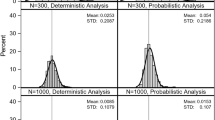Abstract
A health economic model may include a set of related inputs whose true values are uncertain, but that can be assumed to follow a logical order. Various approaches are available for performing probabilistic sensitivity analysis while preserving the order constraint, one such approach is known as the difference method. The difference method approach appears to have many of the required properties, has been endorsed by good practice guidelines, and is likely to prove a popular approach. However, the proposed implementation of the difference method approach is cumbersome, requiring numerical estimation, which might present a barrier to its adoption. Furthermore, it is unclear whether the method can always be applied to three or more model inputs and whether it is unbiased across all possible input values. This study has investigated these three issues for ordered inputs bounded between 0 and 1. An analytic solution is given that allows for more straightforward and compact implementation. The difference method approach cannot always be applied to a set of three or more model inputs, and this depends on the relative size of the variances of the logit-transformed Beta distributions fitted to each variable. The approach can also produce samples with biased means and variances under certain combinations of input means and variances. It is recommended that the difference method approach be used where appropriate; however, an understanding of its limitations is necessary to identify such cases.


Similar content being viewed by others
References
Claxton K, et al. Probabilistic sensitivity analysis for NICE technology assessment: not an optional extra. Health Econ. 2005;14(4):339–47.
National Institute for Health and Care Excellence, NICE health technology evaluations: the manual. 2022.
Ren S, et al. A New approach for sampling ordered parameters in probabilistic sensitivity analysis. Pharmacoeconomics. 2018;36(3):341–7.
Brazier J, et al. Identification, review, and use of health state utilities in cost-effectiveness models: an ISPOR Good Practices for Outcomes Research Task Force Report. Value Health. 2019;22(3):267–75.
Abramowitz M, Stegun IA. Handbook of mathematical functions with formulas, graphs, and mathematical tables. 10th ed. Berlin: National Bureau of Standards Applied Mathematics Series 55; 1972.
van Asten F, et al. The cost-effectiveness of bevacizumab, ranibizumab and aflibercept for the treatment of age-related macular degeneration-A cost-effectiveness analysis from a societal perspective. PLoS ONE. 2018;13(5): e0197670.
Wisloff T, Hagen G, Klemp M. Economic evaluation of warfarin, dabigatran, rivaroxaban, and apixaban for stroke prevention in atrial fibrillation. Pharmacoeconomics. 2014;32(6):601–12.
Bieri U, et al. Management of active surveillance-eligible prostate cancer during pretransplantation workup of patients with kidney failure: a simulation study. Clin J Am Soc Nephrol. 2020;15(6):822–9.
Petelin L, et al. Cost-effectiveness of long-term clinical management of BRCA pathogenic variant carriers. Genet Med. 2020;22(5):831–9.
Thomas SA, et al. Behavioural activation therapy for post-stroke depression: the BEADS feasibility RCT. Health Technol Assess. 2019;23(47):1–176.
Author information
Authors and Affiliations
Corresponding author
Ethics declarations
Funding
The author received no financial support for the research, authorship, or publication of this article.
Conflicts of Interest/Competing Interests
DH-M is an employee of PHMR Limited.
Ethics Approval
Not applicable.
Consent to Participate
Not applicable.
Consent for Publication
Not applicable.
Availability of Data and Material
Not applicable.
Code Availability
Available on request.
Author Contributions
The author confirms sole responsibility for the following: study conception and design, analysis and interpretation of results, and manuscript preparation.
Supplementary Information
Below is the link to the electronic supplementary material.
Rights and permissions
Springer Nature or its licensor (e.g. a society or other partner) holds exclusive rights to this article under a publishing agreement with the author(s) or other rightsholder(s); author self-archiving of the accepted manuscript version of this article is solely governed by the terms of such publishing agreement and applicable law.
About this article
Cite this article
Hill-McManus, D. The Difference Method Approach for Sampling Order Constrained Parameters: An Improved Implementation and Important Limitations. PharmacoEconomics 42, 11–18 (2024). https://doi.org/10.1007/s40273-023-01313-3
Accepted:
Published:
Issue Date:
DOI: https://doi.org/10.1007/s40273-023-01313-3




